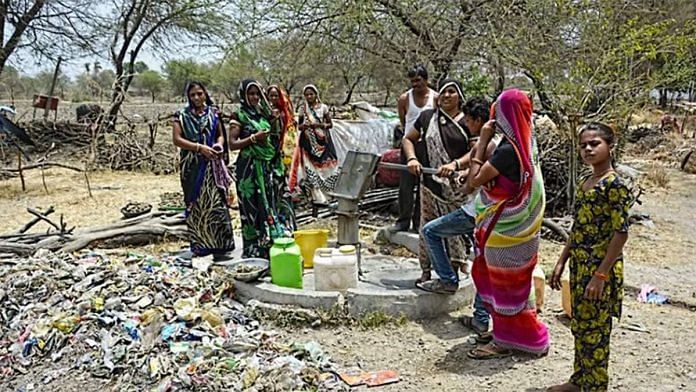New Delhi: About 14 per cent of India’s 7,089 groundwater assessment units across states have been categorised as over-exploited, while another four per cent fall in the critical category, according to the latest report of the Central Ground Water Board (CGWB), released last Wednesday.
According to the CGWB website, groundwater resources are assessed in units such as blocks, talukas or mandals. These are called groundwater assessment units.
An “over-exploited” category indicates groundwater extraction exceeding the annually replenishable groundwater recharge, while the “critical” category is one where the stage of groundwater extraction is between 90-100 per cent. The overall stage of groundwater extraction in the country is 60.08 per cent.
According to the CGWB report — the Dynamic Groundwater Resources of India, 2022 — the stage of groundwater extraction is very high, more than 100 per cent, in the states and union territories of Haryana, Punjab, Rajasthan, Dadra and Nagar Haveli and Daman and Diu.
This means that in these places the annual groundwater consumption is more than annual extractable groundwater resources.
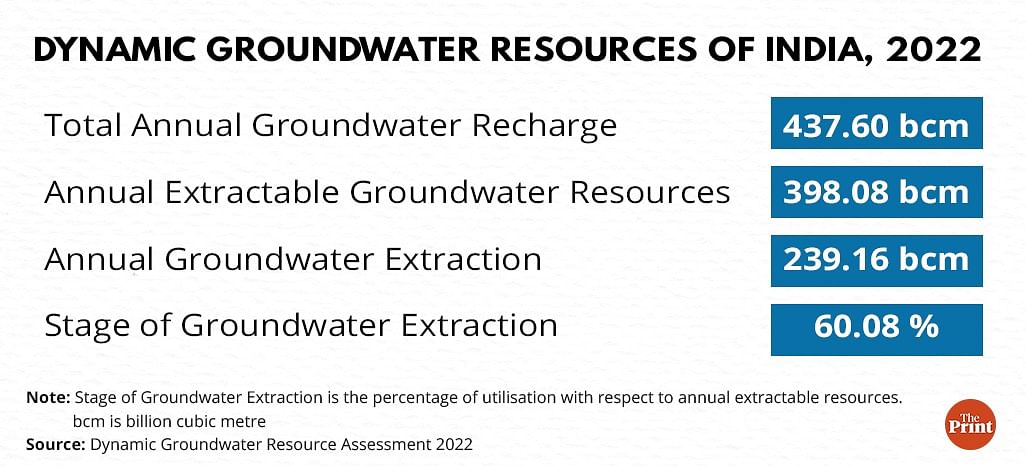
While in Punjab, the stage of groundwater extraction is 165.99 per cent, in Rajasthan it is 165.99 per cent, Haryana 165.99 per cent and in the union territories of Dadra and Nagar Haveli and Daman and Diu, it is 157.927 per cent and 133.2 per cent, respectively. All these fall in the “over-exploited” range, implying that in these states the “annual groundwater consumption is more than annual extractable groundwater resources”.
Delhi — at 98.16 per cent stage of groundwater extraction — falls in the “critical” category (where the stage of extraction is between 90 and 100 per cent).
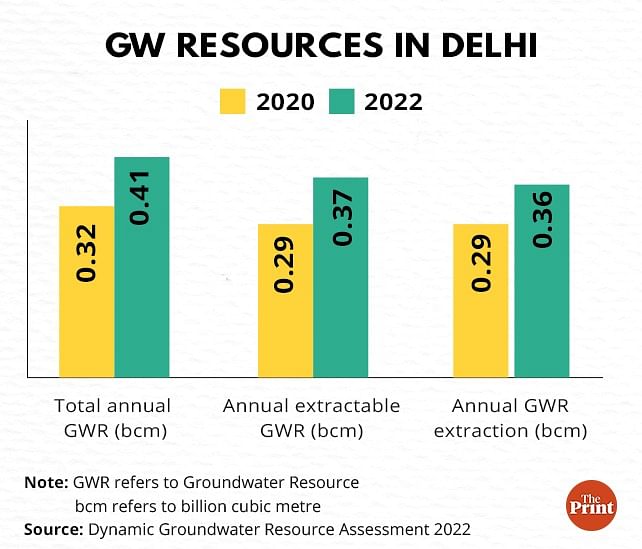
Overall, out of the total 7,089 groundwater assessment units, 1,006 have been categorised as “over-exploited”, 260 as “critical”, 885 as “semi-critical” (where the stage of groundwater extraction is between 70 per cent and 90 per cent) and 4,780 units as “safe” (where the stage of groundwater extraction is less than 70 per cent). Besides, there are 158 assessment units which are completely saline (brackish, containing salt).
The report also found that overall, the groundwater extraction in India has marginally decreased from 244.92 bcm (billion cubic metre) in 2020 to 239.16 bcm in 2022. Even the overall stage of groundwater extraction has marginally decreased from 61.6 per cent to 60.08 per cent.
The total annual groundwater recharge in the country in 2022 has been assessed as 437.60 bcm. According to the report, the largest user of groundwater resources in India is the agricultural sector, for irrigation purposes.
While the report does not mention the months of assessment in 2022, it says the assessment was done by collecting data during the monsoon and non-monsoon periods of this year. It also mentions that due to the Covid-19 outbreak in the past two years, CGWB field activities, including monitoring of water levels, were severely affected and water levels could not be monitored for two consecutive pre-monsoon (April/May) seasons in 2020 and 2021.
The dynamic groundwater resources of India are assessed periodically, according to the Groundwater Estimation Methodology, 2015, which takes into account all the relevant parameters contributing to groundwater recharge and extraction.
Also read: Punjab & Haryana’s 2009 policy to save water worsened air pollution, says ISRO study
Agricultural sector main consumer of groundwater in India
According to the report, about 87 per cent of the total 239.16 bcm groundwater extraction in the country in 2022 was for irrigation purposes. This amounts to about 208.49 bcm of groundwater. Only 30.69 bcm, or 13 per cent of total extraction, was for domestic and industrial use.
In Delhi, Goa, Kerala, Jammu & Kashmir, Ladakh, Manipur, Meghalaya, Mizoram, Nagaland, Tripura, Andaman and Nicobar Islands and Chandigarh, the groundwater extraction for domestic use was more than 40 per cent of total extraction.
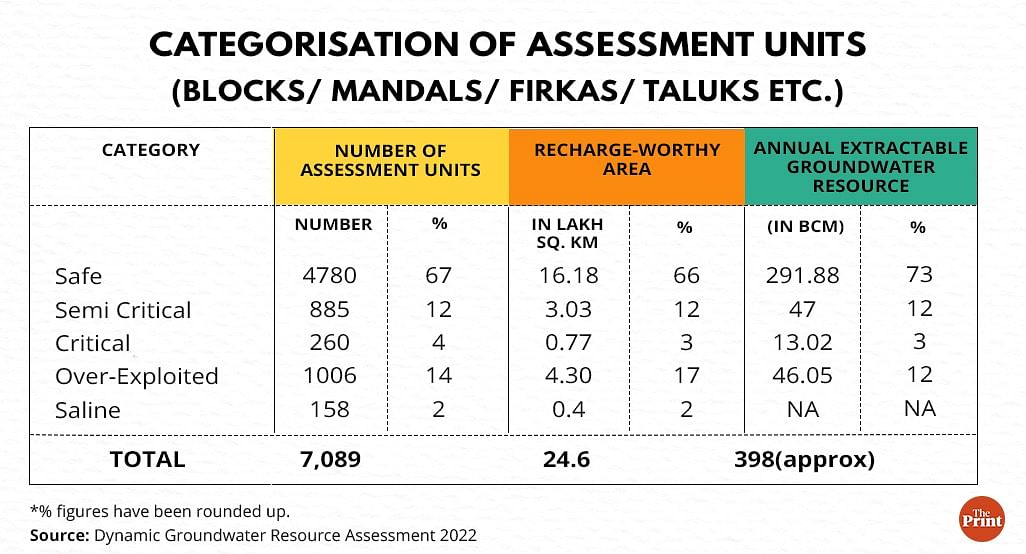
Noted water conservationist Mihir Shah, who is also the chairperson of the National Water Policy Committee, told ThePrint that India is the largest groundwater consuming country in the world and it is the country’s single-most precious resource for agriculture, drinking, and industrial use, which has consistently been exploited.
“China and the United States come in number two and three positions, respectively, but India consumes more groundwater than these nations combined. We are endangering the future of this resource by ‘competitive individualistic exploitation’ that is essentially a common pool resource,” said Shah.
He added: “It doesn’t belong to a single person. In India, we still have British common law from the 19th century, which allows the person who owns a land to use as much water available below his/her land. We must regulate this law.”
Groundwater levels across India
According to the report, the groundwater level data of pre-monsoon 2022 for the country revealed that the general depth of groundwater level in the country ranges between 5 to 10 m bgl (metre below ground level).
Very shallow water levels, of less than 2 m bgl, are observed in patches across states such as Assam, Andhra Pradesh, Meghalaya, Karnataka, Kerala, Jharkhand and Tamil Nadu. Groundwater level in the range of 2-5 m bgl is seen in Assam, northern parts of Uttar Pradesh and Bihar, coastal parts of Odisha, few pockets in Andhra Pradesh, Telangana, Karnataka, Kerala, Tamilnadu, Gujarat and Maharashtra.
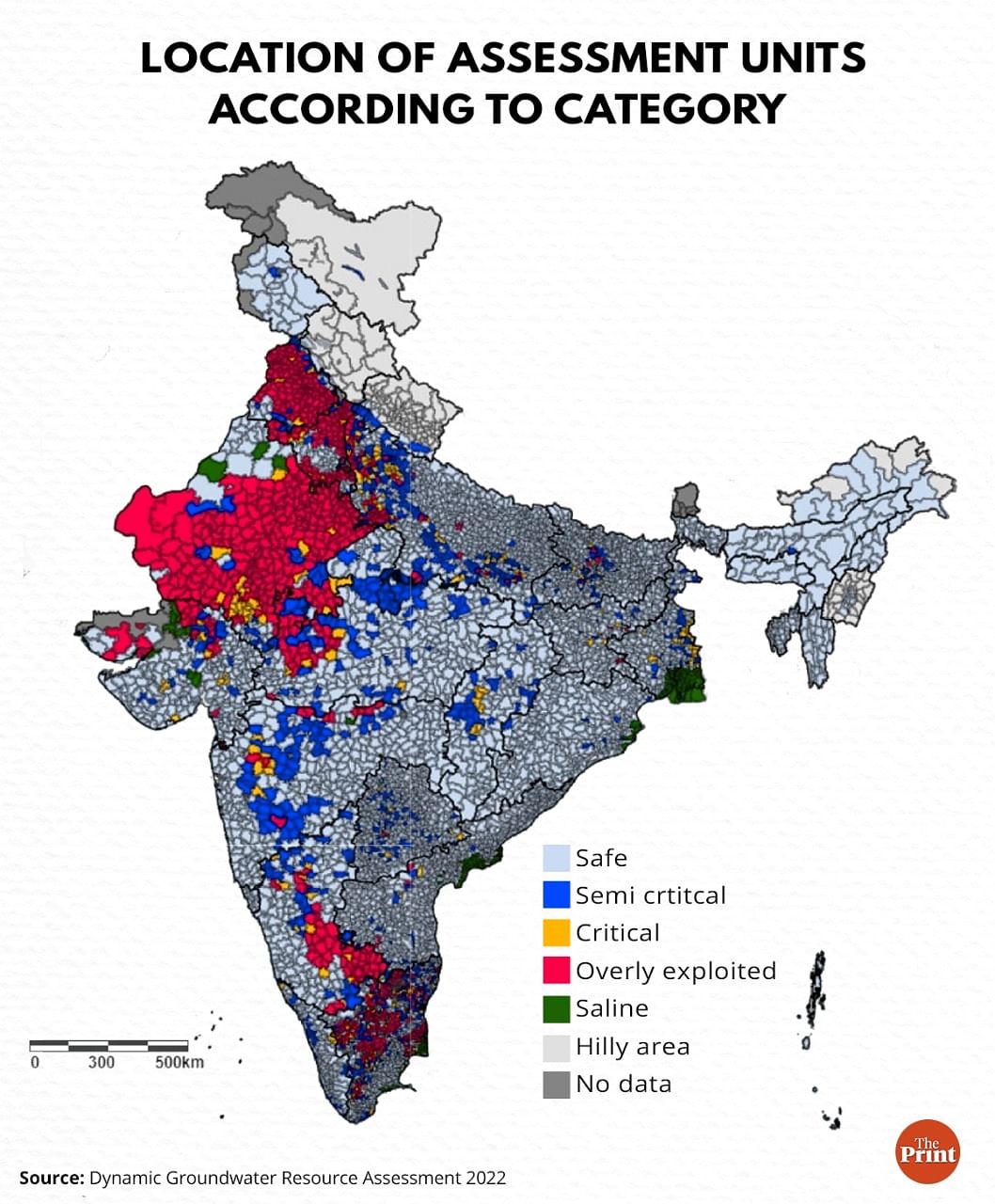
A major part of the country shows the water level in the range of 5-10 m bgl, especially in the states of Madhya Pradesh, Uttar Pradesh, Bihar, Jharkhand, West Bengal, Odisha, Chhattisgarh, Maharashtra, Gujarat, Tamil Nadu, Telangana and Karnataka.
In major parts of north-western and western states, especially in the states of Delhi, Haryana, Punjab and Rajasthan, the groundwater level is generally deeper and ranges from about 20 to more than 40 m bgl. The peninsular part of the country recorded water levels in the range of 5 to 20 m bgl.
The deepest depth to the water level of 130.77 m bgl is observed at Khara in the Jodhpur district of Rajasthan.
(Edited by Poulomi Banerjee)
Also read: In drought-prone Kachchh, Sardar Sarovar project is ‘dream come true’. But not for all farmers


